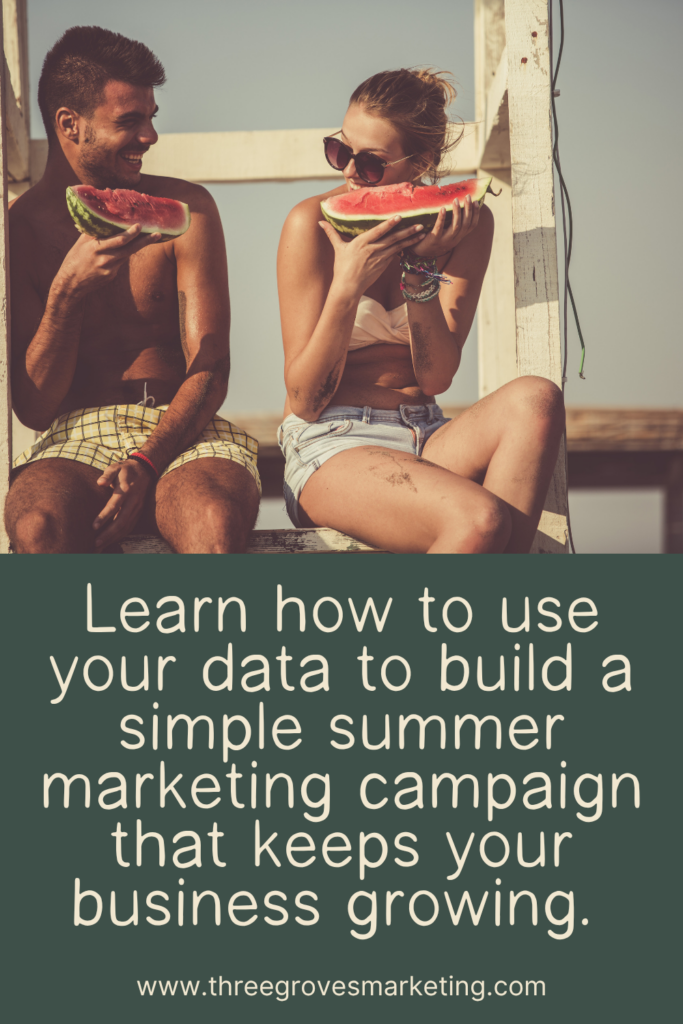Hint: You don’t need to be a numbers girlie to make this work
Every year, around late May, the same cycle starts for service-based business owners:
We swear this will be the summer we finally step back.
More mornings on the porch.
More afternoons with our kids.
More iced coffee, less content creation.
But somehow… we blink and we’re still glued to the laptop.
If you’ve ever felt like you’re trading sunshine for screen time because you have to keep your business afloat, I see you.
Your own marketing data, even if you’ve barely glanced at it, holds the key to doing less this summer while still keeping momentum.
Let’s talk about how your own marketing data can help you work less this summer without slowing your momentum.
Why Summer Is Actually the Best Time to Lean on Your Data
Summer gets chaotic. Kids are home. Vacations are happening. Your energy shifts — and it should.
You already know you want to do less.
The hard part?
Figuring out what to keep and what to toss so your business keeps running while you’re poolside, road-tripping, or just vibing in your own backyard.
If you’ve been marketing your business in any way — Instagram, blogging, email, podcasting — you’re sitting on months (if not years) of clues about what’s already working.
The secret isn’t doing more. It’s looking at the data you already have and letting it guide your next move.
In other words: you don’t need to revamp your strategy. You just need to read the signals and respond accordingly.
Your Summer Essentials Marketing Metrics
Now, I am not about to tell you to start tracking 27 data points in a spreadsheet.
Absolutely not.
What I will tell you is this: you only need to look at FOUR things to build a solid summer plan. That’s it.
1. Visibility Metric
How are new people finding you?
- Pinterest clicks?
- Website traffic from blogs?
- IG story views or Reels reach?
2. First Touch Metric
What’s the first meaningful interaction most folks have with your brand?
- A freebie opt-in?
- A DM reply?
- A click to your Services page?
Knowing how people first come into your world can give you a better idea of what you need to promote more in the summer or what type of content you need to create in order to encourage more of these first touchpoints.
3. Conversion Metric
How are people saying “I’m in”?
- Consults booked?
- Sales page views?
- Checkout completions?
This is your revenue-driver and the one you’ll want to pay the most attention to during the summer!
For example, if most people are jumping into working with you directly from your sales page, that’s a sign that you don’t even need to promote discovery calls.
But, if most people are requesting a call before joining, that’s a sign that you might need to improve your sales page messaging or at the very least streamline your discovery call process to maximize your time! Maybe it’s time to try Voxer for Q&A around your offer.
4. Nurture Metric
How are you keeping warm leads warm?
- Email open/click rates?
- Podcast listens?
- IG broadcast channel taps?
This is how you continue to build connections with the people you are in community with.
Let’s say your metrics show that your podcast listens are down, but your email opens and clicks are way up. That might be a sign that you pause your podcast for the season and increase the amount of times you email your list.
Once you know where your energy is most effective. You can start gently setting the rest down.
→ All four of these together = your summer marketing campaign.
Mini Audit Exercise: Find Your 4 Metrics in 15 Minutes
- Go to Google Analytics (or whatever platform you’re using).
- Find your top traffic source → that’s your Visibility Metric
- Look at your most-visited internal page (other than your home) → likely your First Touch
- What action usually leads to a sale? → identify your Conversion Metric
- Where do you stay in touch with people? → check open/click rates, views, or listens for your Nurture Metric
How to create a summer marketing plan using data
Step 1: Pull what’s working
Look back at the last 60–90 days.
- What platforms are sending you traffic?
- What pages are converting?
- What content are people actually clicking on?
Step 2: Cut the extra
If it’s not doing something helpful or it’s draining you?
Let it go. You can pick it back up in September.
Step 3: Keep a light rhythm
Decide now: are you checking data weekly? Monthly? Not at all?
(Hint: “monthly” is plenty unless you’re mid-launch.)
If your summer looks more like survival mode, that’s totally okay too. Even observing your data without acting on it builds your decision-making muscles for later.
Step 4: Map your summer plan
Circle the 1–3 things you’re going to keep doing because they WORK and feel good.
Then schedule it, batch it, or hand it off if you can.
Boom. Bam. Bow. There is your summer marketing plan!
How to Use This Data to Do Less (Without Losing Momentum)
Here’s what your data might be telling you:
- You’re getting the most traffic from Pinterest, but you’ve been spending all your time on Instagram. Sounds like a good time to take a step back.
- Your email list is converting the best, but you’re only emailing once a month. Now you know you gotta step up your email game!
- Your Services page is getting tons of views, but no one’s booking, maybe it needs a refresh?
When you actually know what’s working, you can:
✅ Drop the marketing tasks that aren’t pulling their weight
✅ Do more of what’s already working
✅ Create a simple summer rhythm that honors your life
Let Your Data Be the Permission Slip You’ve Been Waiting For
You started your business for freedom, right?
Freedom to spend your days in a way that supports your life.
Freedom to be present, whether that’s in the pool, on the porch, or with your people.
Marketing doesn’t have to get in the way of that.
Your summer plan is already in your data. You just need to take a peep!
Inside the Marketing Measurement Playbook you’ll discover which marketing metrics to focus on (and which ones to ignore), a step-by-step process to analyze your data without overwhelm, and how to identify (and fix) any gaps in your marketing for long-term, sustainable growth.
Inside the Analytics Action Plan you’ll get a clear read on your data, 2–3 next steps, and a short-term action plan you can start using right away to keep that momentum going.
A custom Marketing Analytics Dashboard allows you’ll have all the insights you need to grow your business, without the headache of crunching numbers yourself. Learn more about it here.




leave a comment